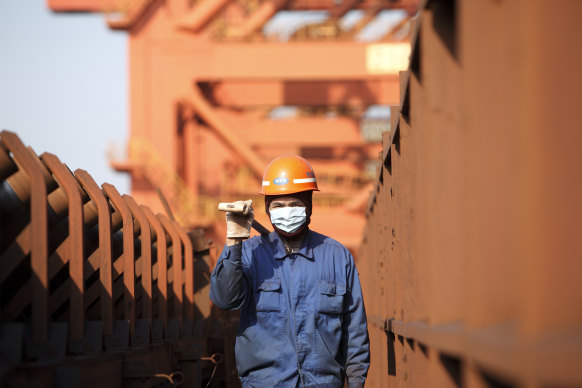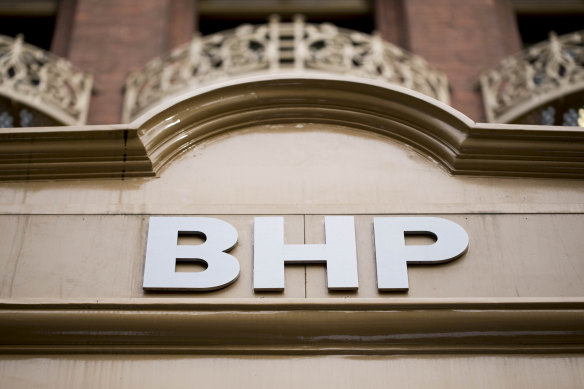
There’s a lot of doom and gloom around the outlook for iron ore, with the iron price tumbling from above $US140 a tonne at the start of 2024 to around $US100 a tonne this week, or roughly the average price BHP realised ($US101 a tonne) last financial year. It has traded below $US100 a tonne recently.
That’s clearly being driven by conditions within China, where the collapse of the country’s property sector has had a major impact on demand for steel and therefore iron ore.

The collapse of China’s property sector has had a major impact on demand for steel and therefore iron ore.Credit: Getty
That impact, exacerbated by the fact that the growth in investment in China’s infrastructure sector, another major driver of demand for steel, has also fallen away because of past over-investment, is unlikely to be short-lived.
Add in the prospect that the first ore from Guinea’s giant Simandou project will probably hit the market from next year, before scaling up over several years to, potentially, 120 million tonnes per annum, and it is easy to see why there is so much pessimism about the sector’s prospects.
BHP, however, has the lowest costs in the sector – C1 cash costs of $US15.84 a tonne and unit costs of $US18.19 a tonne – and has extended its cost advantage over its rivals during the past financial year.
Loading
At an operational level, the miner achieved record production of almost 260 million tonnes and this year will complete studies on the feasibility of increasing its output to 305 million tonnes a year in the medium term and 330 million tonnes in the longer term.
Why would it consider expanding production given that it is improbable that China’s demand is going to bounce back – its steel production, almost all of it unprofitable today, has plateaued at about 1 billion tonnes a year – and there is a major new source of supply about to hit the market?
The low-cost producer can survive any market conditions. It is the marginal producer – in this case a collection of Chinese domestic producers, India and some smaller West Australian miners – that could be forced out of the market.
BHP’s estimate of where the pressure on those marginal producers reached breaking point is around $US80 a tonne.
At that level, BHP would still be generating gross margins of more than $US60 a tonne on increasing volumes that require only incremental investment, unlike the $US23 billion of new capital that is being ploughed into Simandou, with its costly greenfield rail and port facilities.

As a low-cost producer, BHP can survive any market conditions.Credit: Arsineh Houspian
BHP, Rio Tinto and Fortescue also have major transport cost advantage over Simandou, with the WA miners about 14,000 kilometres closer to China than Guinea.
Like Rio, BHP has been here before.
In 2015, amid a sharp deceleration in China’s growth as it tried (unsuccessfully) to shift its economy from an over-reliance on exports towards domestic consumption, a meltdown on China’s sharemarket and a fumbled devaluation of its currency, the iron ore price fell towards $US40 a tonne.
Further back, before the global financial crisis in 2008 that caused China to embark on one of the world’s largest stimulus programs – and resulted in a boom in infrastructure and property investment that evolved into the property bubble that Xi Jinping burst in 2020 with his restrictions on property developers’ leverage – prices had always been below $US40 a tonne and, in real terms, falling.
The post-2008 period, during which prices have spiked above $US200 a tonne, has been an aberration for the sector, not the historical norm.
The transition to a lower carbon emission global economy will require steel for electric vehicles, wind turbines and the like, and so there will be a floor under demand but, without the demand from construction within China, it is unlikely that prices will bounce dramatically.
Therefore, the continued increased in low-cost volumes coming from the three big WA iron ore miners – BHP, Rio and Fortescue – and from Vale’s established mines in Brazil should push out the more vulnerable producers while they continue to generate solid profits.
The cash flows and profits from its West Australian mines underwrite BHP’s ability to invest in its future-facing commodities while producing strong cash returns to shareholders. (Albeit because it plans to increase the investment in its suite of existing assets, not as strong in the latest financial year as they were in the previous one.)
Its capital expenditures were $US9.3 billion last financial year, tilted towards copper and potash, and it has foreshadowed increasing investment to about $US11 billion this year and into the medium term.
Loading
Those numbers don’t include any major acquisitions although despite the failure of its efforts to get the Anglo American board to engage with what would have been a $US75 billion acquisition, BHP isn’t ruling out future acquisitions, probably in copper. That is even though it is already one of the world’s major copper producers and one with many prospective resources in South Australia and South America.
The continuing growth of its copper production and the expected first potash production from Jansen in 2026 will progressively diversify BHP’s resource base and make it less dependent on iron ore.
BHP’s aspiration of increasing its iron ore production, however, underscores its conviction that the business will continue to play a central role in its performance long into the future.
The Business Briefing newsletter delivers major stories, exclusive coverage and expert opinion. Sign up to get it every weekday morning.









 Add Category
Add Category